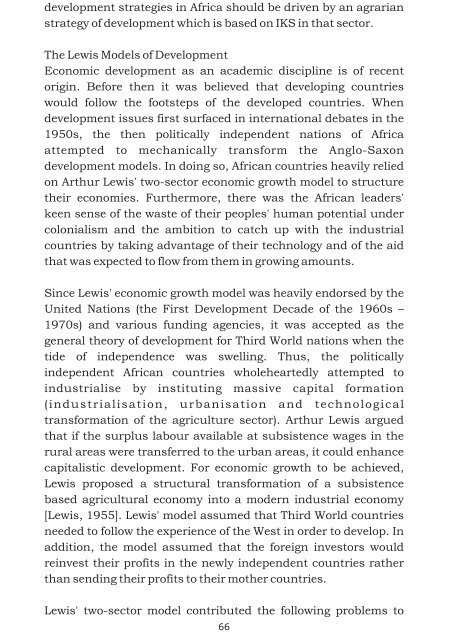Beneficiaries are actors too.pdf - Southern Institute of Peace ...
Beneficiaries are actors too.pdf - Southern Institute of Peace ...
Beneficiaries are actors too.pdf - Southern Institute of Peace ...
You also want an ePaper? Increase the reach of your titles
YUMPU automatically turns print PDFs into web optimized ePapers that Google loves.
development strategies in Africa should be driven by an agrarian<br />
strategy <strong>of</strong> development which is based on IKS in that sector.<br />
The Lewis Models <strong>of</strong> Development<br />
Economic development as an academic discipline is <strong>of</strong> recent<br />
origin. Before then it was believed that developing countries<br />
would follow the footsteps <strong>of</strong> the developed countries. When<br />
development issues first surfaced in international debates in the<br />
1950s, the then politically independent nations <strong>of</strong> Africa<br />
attempted to mechanically transform the Anglo-Saxon<br />
development models. In doing so, African countries heavily relied<br />
on Arthur Lewis' two-sector economic growth model to structure<br />
their economies. Furthermore, there was the African leaders'<br />
keen sense <strong>of</strong> the waste <strong>of</strong> their peoples' human potential under<br />
colonialism and the ambition to catch up with the industrial<br />
countries by taking advantage <strong>of</strong> their technology and <strong>of</strong> the aid<br />
that was expected to flow from them in growing amounts.<br />
Since Lewis' economic growth model was heavily endorsed by the<br />
United Nations (the First Development Decade <strong>of</strong> the 1960s –<br />
1970s) and various funding agencies, it was accepted as the<br />
general theory <strong>of</strong> development for Third World nations when the<br />
tide <strong>of</strong> independence was swelling. Thus, the politically<br />
independent African countries wholeheartedly attempted to<br />
industrialise by instituting massive capital formation<br />
(industrialisation, urbanisation and technological<br />
transformation <strong>of</strong> the agriculture sector). Arthur Lewis argued<br />
that if the surplus labour available at subsistence wages in the<br />
rural <strong>are</strong>as were transferred to the urban <strong>are</strong>as, it could enhance<br />
capitalistic development. For economic growth to be achieved,<br />
Lewis proposed a structural transformation <strong>of</strong> a subsistence<br />
based agricultural economy into a modern industrial economy<br />
[Lewis, 1955]. Lewis' model assumed that Third World countries<br />
needed to follow the experience <strong>of</strong> the West in order to develop. In<br />
addition, the model assumed that the foreign investors would<br />
reinvest their pr<strong>of</strong>its in the newly independent countries rather<br />
than sending their pr<strong>of</strong>its to their mother countries.<br />
Lewis' two-sector model contributed the following problems to<br />
66


